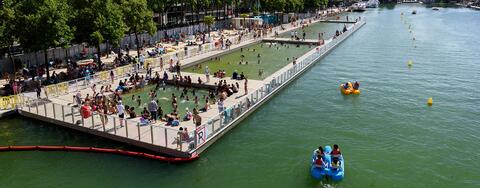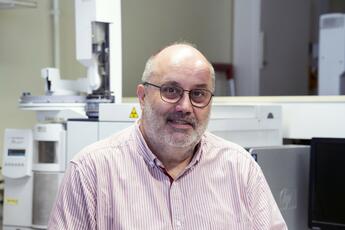
A return to swimming in the Seine?
Banned since 1923 due to health risks, swimming in the Seine should be possible again starting in 2025. While Jacques Chirac promised in 1990 to make the river clean enough to swim in, his promise is set to become reality thirty-five years later, on the occasion of the Paris 2024 Olympic Games.

A former director of a laboratory at École des Ponts ParisTech, Jean-Marie Mouchel has been working on urban water quality and its impact on the environment for many years. In 2006, he joined Sorbonne University as a full professor to head the interdisciplinary research program on water and the environment in the Seine basin (Piren-Seine). Now director of the Metis joint research unit, he looks back at the challenges of Seine water quality for bathing.
"The Olympics were a lever for accelerating the clean-up of the Seine," says Jean-Marie Mouchel, who headed the Piren-Seine program from 2007 to 2015. Launched 35 years ago, this program aims to study the quality and flow of groundwater and rivers in the Seine basin. Funded by the water managers of the Seine basin, it brings together a multidisciplinary research team comprising hydrologists, chemists, biologists, climatologists, hydraulic engineers, mathematicians, physicists, as well as economists, sociologists, political scientists and historians. This diversity of skills enables us to approach water-related issues from different angles, and to propose integrated solutions and sound scientific models. "We try to answer questions in a global way, within a multidisciplinary scientific framework, to provide useful information on policies that elected representatives could pursue", explains Jean-Marie Mouchel.
A century of bans
This program has helped to improve the quality of the Seine's water, which had largely deteriorated over a century ago. "In the second half of the 19th century, sewers were created to collect rainwater and street washing water, which was sent downstream as fertilizer for market gardening or discharged into the Seine," explains the scientist. However, the introduction of mains drainage at the end of the 19th century led to an increase in the pollution load. The quantities discharged increased considerably, until the system reached saturation point in the early 20th century.
The first major wastewater treatment plant was built in 1938, but it was not until after the Second World War that more effective measures were taken. The Water Act of 1964 enabled the creation of financial agencies for the basin, which established a system for financing the costly infrastructure required to meet water and wastewater needs: residents' water bills include a charge levied to finance wastewater treatment, water supply and new networks.
Over the last few decades, progress on water quality has been significant, and the members of the Piren-Seine program have contributed to this. "For example, we have analyzed in detail the causes of the Seine's poor quality, and designed predictive models to assess the impact of new structures, such as the storage basin currently under construction next to the Gare d'Austerlitz, which will be able to store tens of thousands of cubic meters," explains the researcher. Networking has also made it possible to divert excess water during rainy periods to the areas least affected, while soil desiltation has limited runoff into the Seine. Thanks to these solutions, the number of storm spills has fallen year on year. "Today, in the Paris vicinity, in dry weather, only water that has been treated to a level deemed sufficiently good is discharged into the Seine, achieving a treatment rate of 90 to 98% depending on the plant, for elements such as carbon and nitrogen", says the scientist.
Swimming soon to be possible
The issue of bathing raised by the Paris Olympics has brought a new impetus. Two water treatment plants have been equipped with advanced disinfection systems, such as the use of ultraviolet rays or oxidizing treatments, to eliminate pathogens present in treated wastewater. These disinfection measures are producing encouraging results, with levels of fecal indicator bacteria below regulatory thresholds. Jean-Marie Mouchel's team keeps a close eye on these parameters and carries out prospective analyses of the Seine's water quality, useful for drawing up management plans: "In particular, we are conducting trials to better understand the disinfectant role of sunlight and quantify the biological mechanisms by which residual fecal bacteria are degraded," says the researcher. “We are also developing connected models that will enable us to predict water quality in real time".
But bathing doesn't just mean having sufficiently clean water, it also means putting in place the infrastructure and services essential to bathe safety. "A bathing area shouldn't be set up just anywhere. There are neighborhood issues, and managing multiple uses of the water remains complex, as the Seine is also used for navigation. It's essential to strike a balance between these different uses. Especially as global warming will increase the demand for cooling by city dwellers," explains Jean-Marie Mouchel.
And while contamination problems in dry weather have been resolved thanks to well-functioning sewerage networks and wastewater treatment plants, there are still problems during storms. "Despite all our efforts, we are unable to collect, let alone treat, the gigantic volumes of polluted water, efforts are still needed to solve runoff problems and poor connections between wastewater and stormwater networks." By providing rapid predictions of water quality after rainfall events, the scientists hope to facilitate water management decision-making to guide environmental policies and to consider necessary future developments. While we wait for all the lights to turn green for a dip in the Seine, Paris City Hall will be opening the Canal Saint-Martin to bathing this summer, as it did last year, on Sundays from July 9 and August 20.
